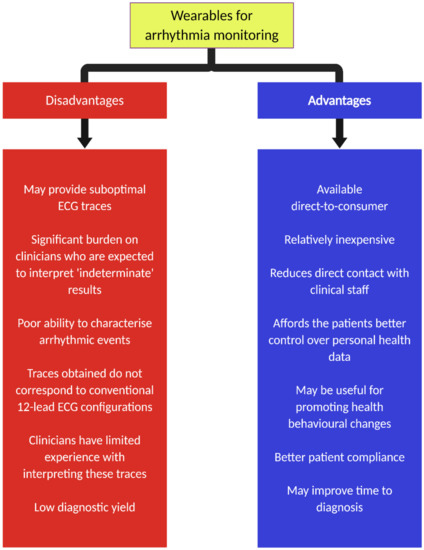Smart Wearables for Cardiac Monitoring
Medical devices marketed directly to consumers (DTC) are becoming increasingly more complex, capable to diagnose a variety of cardiovascular issues. Remote patient follow-up by monitoring heart rate is most popular, as it does not require complex analyses of cardiac waveforms such as ECG and PPG. Most known devices - such as Apple watch - are used for the surveillance or “spot checking” of arrhythmias. The amount and quality of data recorded and stored depend on the battery capacity, storage capabilities, size of the device and cost of the device.
The management of non-atrial fibrillation arrhythmias is done using devices placed at a care provider's office during a scheduled appointment - like Holter, event recorder, and electrocardiogram (ECG) patches. Wristbands and textiles are also used by some providers. New lightweight designs such as a single-patch 12-lead ECG (SP-ECG) are also being researched. Implementation in other patient cohorts, such as ST-elevation myocardial infarction (STEMI), heart failure or sleep apnea, is feasible and expanding.
Modern optical photoplethysmographic (PPG) sensor devices can provide useful clinical information on multiple issues such as blood pressure, respiratory processes, sympathetic nervous system activity, heart rate variability, irregular heartbeat, even infectious diseases and diabetes. Multi-site photoplethysmography (MPPG) based on measurements of pulse wave (index finger, toe, and ear) and heart rate was successful for examining arterial stiffness in pediatric heart-transplant-recipients. Many other studies were able to utilize differences in the peripheral heart rates for a variety of health measurements - such as monitoring blood sugar levels.
DTC devices operated by patients will remain limited due to their under-detection of subclinical or minimally symptomatic arrhythmias and the need of expert knowledge for placement of sensors for non-arrhythmia applications. Besides, they are less accurate during activities such as walking, gardening, and doing household chores compared to desk work and relaxation. This can be overcome with better technology, but for the data to influence therapeutic decisions and medical decision making, the claims must be supported with data of safety, efficacy and value.
| HF Parameter | Method | Device |
|---|---|---|
| Thoracic fluid | Thorax impedance measurement, remote dielectric sensing, seismocardiography | Patch, vest, smart shirt |
| Activity | Pedometers, accelerometers, | Patch, wrist band, smart watch, smart shirt |
| Blood pressure | Sphygmomanometer | Smart watch, wristband |
| Body Weight | Body weight measurement | Smart socks, scale |
| NYHA functional class | Questionnaires, applications | Smart phone, tablet |
| QoL | Questionnaires, applications | Smart phone, tablet |
| Heart rate, heart rhythm | ECG, PPG | Smart watch, wrist band, patch, chest band, smart shirt |
REFERENCES
Duncker D, Ding WY, Etheridge S, Noseworthy PA, Veltmann C, Yao X, Bunch TJ, Gupta D. Smart wearables for cardiac monitoring—real-world use beyond atrial fibrillation. Sensors. 2021 Apr 5;21(7):2539.
Hillmann HA, Hohmann S, Mueller-Leisse J, Zormpas C, Eiringhaus J, Bauersachs J, Veltmann C, Duncker D. Feasibility and First Results of Heart Failure Monitoring Using the Wearable Cardioverter–Defibrillator in Newly Diagnosed Heart Failure with Reduced Ejection Fraction. Sensors. 2021 Nov 23;21(23):7798.
Georgieva-Tsaneva G, Gospodinova E, Cheshmedzhiev K. Cardiodiagnostics Based on Photoplethysmographic Signals. Diagnostics. 2022 Feb 5;12(2):412.
D'Alvia L, Ferranti D, Romiti G, Rizzuto E, Cangemi R, Laudani A, Basili S, Fulginei FR, Del Prete Z. Accuracy evaluation of an ECG device for heart failure patients self-monitoring: a preliminary study. In2022 IEEE International Symposium on Medical Measurements and Applications (MeMeA) 2022 Jun 22 (pp. 1-6). IEEE.
Sharkey EJ, Di Maria C, Klinge A, Murray A, Zheng D, O’Sullivan J, Allen J. Innovative multi-site photoplethysmography measurement and analysis demonstrating increased arterial stiffness in paediatric heart transplant recipients. Physiological Measurement. 2018 Aug 1;39(7):074007.
Přibil J, Přibilová A, Frollo I. Comparative measurement of the PPG signal on different human body positions by sensors working in reflection and transmission modes. Engineering Proceedings. 2020;2(1):69.
Giggins OM, Doyle J, Smith S, Crabtree DR, Fraser M. Measurement of Heart Rate Using the Withings ScanWatch Device During Free-living Activities: Validation Study. JMIR Formative Research. 2022 Sep 1;6(9):e34280.


Comments
Post a Comment